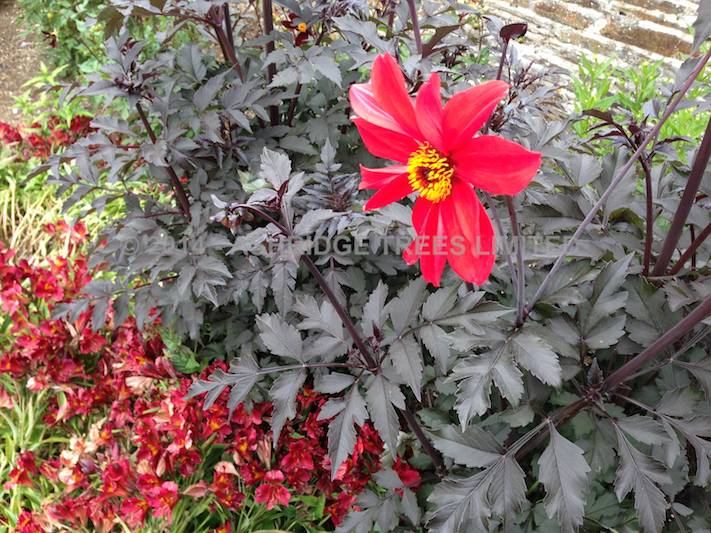And why it is it copper anyway? Contemporary gardeners often use dark colours…look how the ‘Queen of the Night’ tulip has become ubiquitous, and the black grass Ophiopogon planiscarpens nigrescens pops up in urn plantings or as a contrast to pale paving.
There is something fascinating about the pool of shade that sombre colours cast to set off bright, hot colours or cool pastels. I love copper or purple foliage in a garden. My father always maintained that one should never see more than one copper beech in a view and although that is a judgement that is only relevant to a very large garden, there is some truth to not overdoing the amount of copper or purple foliaged plants in your garden because their main impact comes from their contrast with the rest of the garden.

I have always wondered how copper coloured foliage photosynthesises so that the plant can survive. Plants photosynthesise using chlorophyll, a green pigment found in chloroplasts in leaves, which traps sunlight to enable the plant to convert carbon dioxide and water to the sugars that it needs to grow. Chloro is Greek for green and the only part of the light spectrum that chlorophyll does not absorb is the green part which is why we see most leaves as green. The by-product of this reaction is oxygen. Copper leaves also contain and use chlorophyll, but the green colour is masked by the stronger colours of other pigments that in a normal green leaf only become visible in autumn when the chlorophyll begins to degrade as the days shorten. Anthocyanins are bluey-purple and are celebrated in foods like blueberries where they are accorded super antioxidant status. Anthocyanins predominate in purple leaves. Other pigments like xanthophylls are yellowy and carotenes (yes, as in carrots) are more orange-red. Some of these pigments do photosynthesise, but less efficiently than chlorophyll.

The largest and most obvious copper plant is the copper beech Fagus sylvatica ‘Purpurea’ or which looks fabulous next to the bright lime green of a Gleditisia or Maple Acer Cappadocian Aureum but for my money I would plant something like a pink horse chestnut, Aesculus carnea briottii for a full-on techni-colour experience. Equally, copper beech make a fabulous and unusual hedge which, in spite of being deciduous, holds its leaves during the winter and makes a great backdrop to an herbaceous border full of pale or lime green flowers. But my real love of copper plants comes less from the Downton Abbey end of the spectrum than to trips to Japan.
No Japanese garden worth its salt would be without its Acer palmatum – named for its hand-shaped leaf – and its Barbara Cartland confection of cherry blossom. Acer palmatum ‘Atropurpurea’ or ‘Garnet’ have wonderful coppery, burnished leaves. Sadly for me, I have yet to find the right spot to grow them. They originally hail from woodland and forest and so do not like a draught and require soil that is full of organic matter. My heavy clay on top of a hill is far from ideal. It is possible to grow Acers in pots but growing anything in a pot requires lots of TLC and watering and bubble wrap in the winter to prevent frost damage, so I am loathe to do so.
Less temperamental and great for a smaller garden is the fascinating Smokebush, Cotinus coggygria ‘purpurea’. If you can resist clipping it back Cotinus produces clouds of feathery flowers that really do look like the smoke signals that the Apaches sent up in the Westerns of old. The flowers are so ethereal that I want to stroke them. An alternative would be Sambucus nigra. I am never quite sure whether I like its frilly, granny-pink flowers that remind me slightly of dodgy lingerie, but there is something that makes me keep it in the garden nonetheless. Probably, having failed with the Acers, I view the Sambucus as a poor man’s version that I can actually keep alive. Or maybe it is the curiosity to try to make elderflower cordial with the pink flowers and see if it comes out pink. Digressing wildly, my top tip when making elderflower cordial is to use oranges as well as lemons when you leave the elderflowers macerating in the sugar syrup. Somehow the taste is less cloying, and I am yet to meet someone who does not prefer it.

And if you feel that all of these copper options would make too large a statement in your garden there are always crab apple trees, like Malus ‘Profusion’ or ‘Red Standard’, Heucheras – I love ‘Plum Pudding’, the wonderful ‘Bishop of Llandaff’ dahlia and many others. Any of them would look great in June when everything is at its greenest. I am not sure why I said that as it is August and the “Bishop” is looking better than ever….
By Georgina
